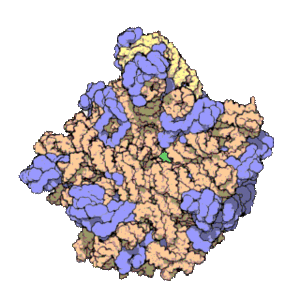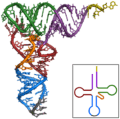Non-coding RNA facts for kids
A non-coding RNA (often called ncRNA) is a special type of RNA molecule. Unlike most RNA, it doesn't carry instructions to build proteins. Instead, ncRNAs have many other important jobs inside living cells. Think of them as busy helpers that make sure everything works correctly, even though they aren't building blocks themselves.
Sometimes, ncRNAs are also called non-protein-coding RNA (npcRNA) or functional RNA (fRNA). If an ncRNA is very short, especially in bacteria, it might be called a small RNA (sRNA). The part of DNA that gives instructions to make an ncRNA is often called an 'RNA gene'.
Different Kinds of ncRNAs
Scientists have found many different types of ncRNAs, and they are still discovering more! Some of the most common and important ones include:
- Transfer RNA (tRNA): These are like tiny delivery trucks. They bring the right building blocks (called amino acids) to the protein-making factories in the cell.
- Ribosomal RNA (rRNA): These are the main parts of the protein-making factories themselves, called ribosomes.
- MicroRNAs (miRNAs): These are very small ncRNAs that help control which genes are active. They can turn genes "off" or "down," which is important for how cells grow and develop.
- Small interfering RNAs (siRNAs): Similar to microRNAs, these also help control genes, often by stopping viruses or protecting the cell's own DNA.
- Small nucleolar RNAs (snoRNAs): These help change other RNA molecules, especially ribosomal RNA.
- Small nuclear RNAs (snRNAs): These are important for editing RNA messages before they are used to make proteins.
- Long noncoding RNAs (long ncRNAs): These are longer ncRNAs that have many different roles, often helping to control genes.
Scientists believe there are thousands of ncRNAs in the human body. However, it's a big challenge to figure out what each one does. Some might not even have a special job.
When We First Learned About ncRNAs
The very first non-coding RNA that scientists studied in detail was an alanine tRNA. It was found in baker's yeast, which is used to make bread. Scientists figured out its structure and shared their findings in 1965. This was a big step in understanding how these important molecules work.
Images for kids
See also
 In Spanish: ARN no codificante para niños
In Spanish: ARN no codificante para niños





